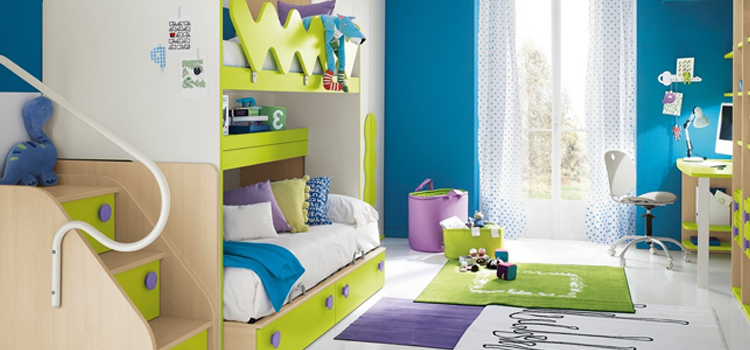
Guidelines for Kids’ Bedroom Interior design
Designing a kids’ bedroom is a delightful yet challenging task. It involves creating a space that is not only visually appealing but also safe, functional, and conducive to a child’s growth and development. One of the key aspects of interior designing a kids’ bedroom is adhering to appropriate measurement guidelines. In this article, we’ll explore the essential measurement guidelines for kids’ bedrooms from the perspective of an interior designer.
Safety First: Understanding Measurements
Ensuring the safety of children should always be the top priority when designing their bedrooms. This begins with understanding standard measurements for kids’ bedroom furniture. Beds, dressers, desks, and other furniture pieces should be proportionate to the size of the room and the child using them. Additionally, it’s crucial to consider safety aspects such as rounded edges and stable constructions to prevent accidents.
Optimizing Space: Efficient Layouts
A well-designed layout can make a significant difference in the functionality and aesthetics of a kids’ bedroom. When arranging furniture, aim for a layout that maximizes space utilization while maintaining an open and inviting atmosphere. Consider factors such as traffic flow, natural light, and accessibility when planning the layout.
Growth Considerations: Adjustable Features
Children grow quickly, and their needs change over time. To accommodate their growth, consider incorporating adjustable features into the bedroom design. This may include height-adjustable desks, extendable beds, and modular storage solutions that can adapt to changing requirements.
Personalization: Tailoring to Kids’ Needs
Every child is unique, and their bedroom should reflect their individual personality and preferences. Customizing measurements based on the child’s age, interests, and activities can create a space that feels truly personalized. Involve the child in the design process to ensure their input is valued and incorporated into the final design.
Storage Solutions: Organizing Essentials
Effective storage is essential in a kids’ bedroom to keep clutter at bay and maintain a tidy and organized space. Utilize measurements to optimize storage solutions such as built-in closets, shelving units, and under-bed drawers. Get creative with storage solutions to accommodate toys, clothes, books, and other essentials.
Safety Measures: Avoiding Hazards
In addition to furniture safety, it’s important to consider other potential hazards in a kids’ bedroom. Ensure that window treatments comply with safety standards to prevent accidents, and childproof the room with safety latches on drawers and cabinets. Eliminate tripping hazards by securing rugs and cords, and anchor heavy furniture to the wall to prevent tipping.
Lighting and Accessibility: Enhancing Comfort
Proper lighting is crucial in a kids’ bedroom for tasks such as reading, studying, and playing. Choose lighting fixtures that provide adequate illumination without being too harsh or glaring. Ensure accessibility by placing light switches and outlets within easy reach of children, and consider installing dimmer switches for adjustable lighting levels.
Color and Décor: Creating a Stimulating Environment
The color scheme and décor of a kids’ bedroom can significantly impact the mood and atmosphere of the space. Use measurements to balance different colors and patterns effectively, creating a stimulating yet harmonious environment. Incorporate age-appropriate décor elements such as wall decals, artwork, and themed accessories to add personality to the room.
Flooring and Rugs: Soft and Safe Surfaces
Children spend a lot of time playing on the floor, so it’s essential to choose flooring materials that are comfortable, durable, and easy to clean. Carpeting provides a soft and safe surface for young children, while hardwood or laminate flooring offers versatility and easy maintenance. When selecting rugs, choose materials that are non-toxic and hypoallergenic, with appropriate measurements to fit the room’s layout.
Ventilation and Air Quality: Healthy Living Spaces
Good ventilation is essential for maintaining a healthy indoor environment, especially in a kids’ bedroom where children spend a significant amount of time. Ensure proper measurements for windows to allow for adequate airflow and natural ventilation. Consider installing air purifiers or humidifiers to improve air quality and create a more comfortable and conducive sleeping environment.
Technology Integration: Balancing Innovation and Safety
In today’s digital age, technology plays a significant role in children’s lives. When integrating technology into a kids’ bedroom design, it’s essential to strike a balance between innovation and safety. Choose age-appropriate devices and ensure that electrical outlets and wiring are safely concealed to prevent accidents. Set boundaries for screen time and promote healthy tech habits from a young age.
Parental Involvement: Collaborating with Children
Designing a kids’ bedroom should be a collaborative process between parents and children. Involve children in decision-making regarding colors, themes, and décor choices to create a space that reflects their interests and preferences. Listen to their input and incorporate elements that make them feel comfortable and empowered in their own space.
Budget-Friendly Tips: Making the Most of Resources
Designing a kids’ bedroom doesn’t have to break the bank. With smart measurement choices and creative thinking, it’s possible to create a stylish and functional space on a budget. Look for affordable alternatives to high-end furniture and accessories, such as DIY projects, thrift store finds, and repurposed items. Focus on investing in quality pieces that will withstand the test of time and grow with the child.
Conclusion
In conclusion, measurement guidelines play a crucial role in designing a safe, functional, and visually appealing kids’ bedroom. By understanding the importance of appropriate measurements and incorporating them into the design process, parents and interior designers can create a space that nurtures a child’s growth and development while reflecting their individual personality and preferences.
At LeFreddo we can help by applying our expertise in space planning, furniture selection, and safety considerations to create a functional and visually appealing kids’ bedroom. We can ensure that measurements are optimized for safety, comfort, and efficient use of space, while also incorporating personalized touches that reflect the child’s personality and interests. Additionally, we can provide valuable insights into color schemes, décor elements, and storage solutions to enhance the overall design of the room. Contact us http://www.lefreddo.com/interior-designers-in-salem/
